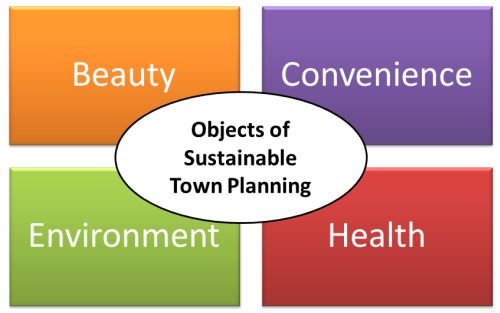Town planning cannot be studied in isolation. It involves the study of various subjects such as engineering, architecture, surveying, transportation planning etc. The intention of the town planning is to satisfy the needs of our future generations and prevent the haphazard growth of the town. Some of the guiding principles of town planning are as follows.
The town should be divided into suitable zones such as commercial zone, industrial zone, residential zone, etc. and suitable rules and regulations should be formed for the development of each zone.
2. Green Belt
Green belt is non-development zone on the periphery of the town. It prevents the haphazard sprawl of the town restricting its size. In essence, a green belt is an invisible line designating a border around a certain area, preventing development of the area and allowing wildlife to return and be established. Greenways and green wedges have a linear character and may run across the town and not around the town.
3. Housing
Housing has to be carefully studied and designed to suit the local population. Care should be taken to see that there is no development of slums since it would be responsible for degrading the life of the citizens. There are various types of housing styles. When a landuse plan is made, zones for independent housing, midrise buildings, high rise buildings are allocated.
4. Public Buildings
Public buildings should be well grouped and distributed throughout the town. Unnecessary concentration of public buildings should be avoided. Factors such as parking facilities, road widths have to be taken into consideration while allocating the space for public buildings.
5. Recreation Centres
Recreation centres have to be given importance while designing a town. They are necessary for the recreational activities of the general public. They include parks for walking and cycling, amusement parks etc.
6. Road Systems
Road network hierarchy is very important. The efficiency of any town is measured by the layout of its roads. A nicely designed road system puts a great impression in the minds of people, especially the visitors to the town. The provision of a faulty road system in the initial stages of town formation proves to be too difficult and costly to repair or to re-arrange in future.
7. Transport Facilities
The town should be provided with suitable transport facilities so that there is minimum loss of time from place of work to the place of residence. Efficiency in transport facilities includes both public and private networks. Public transportation network includes access to buses, trains, trams and trolleybuses. Efficiency in using the public transport will determine the success of that town in terms of design.
Objectives of Town Planning:
The main objectives of the town planning may be summarized in three words viz. Health, Convenience, Beauty and Environment.
1. Health
To make right use of the land for the right purpose by proper division of land called zoning such as residential, commercial industrial, institutional and recreational etc. inorder to avoid the encroachment of one zone upon other for smooth and orderly development of the town or city without causing future conflicts. To create and promote healthy conditions and environments for all the people – rich and poor, to live, to work, to play or relax.
2. Convenience
The object of convenience is meant in the form of various needs of the community such as social, economic, cultural and recreational amenities etc. Public amenities requiredfor the proper upkeep of the citizens include water supply, sanitation, electricity, post,telegraph, gas etc., proper sites for industrial, commercial, business enterprises toencourage them in trade with cheap power, transport services, drainage etc. Recreational amenities include open spaces, parks, gardens and playgrounds, for children and town halls stadiums, community centers, cinema houses, and theatres for adults.
3. Beauty
To preserve the individuality of the town by developing it on its most suited natural conditions. To preserve the aesthetics in the design of all elements of town or city plan, which includes preservation of trees, natural greenery, improved types of domestic buildings and buildings of civic dignity and beauty, architectural control on public as well as semi-public buildings, ancient architectural buildings, temples, churches, mosques and buildings of cultural and historical importance.
4. Environment
It is an important factor in town planning. The environment of the town should be in such a way that people can lead their normal activities with least difficulty. The complex problems of modern society such as tiresome travel to work, long hours of work, limited time spent within the family and community, etc. has led to serious problems in the lifestyle of the people living in the towns, therefore, town planning is mainly concerned with brining about a better relation between man and his environment.


